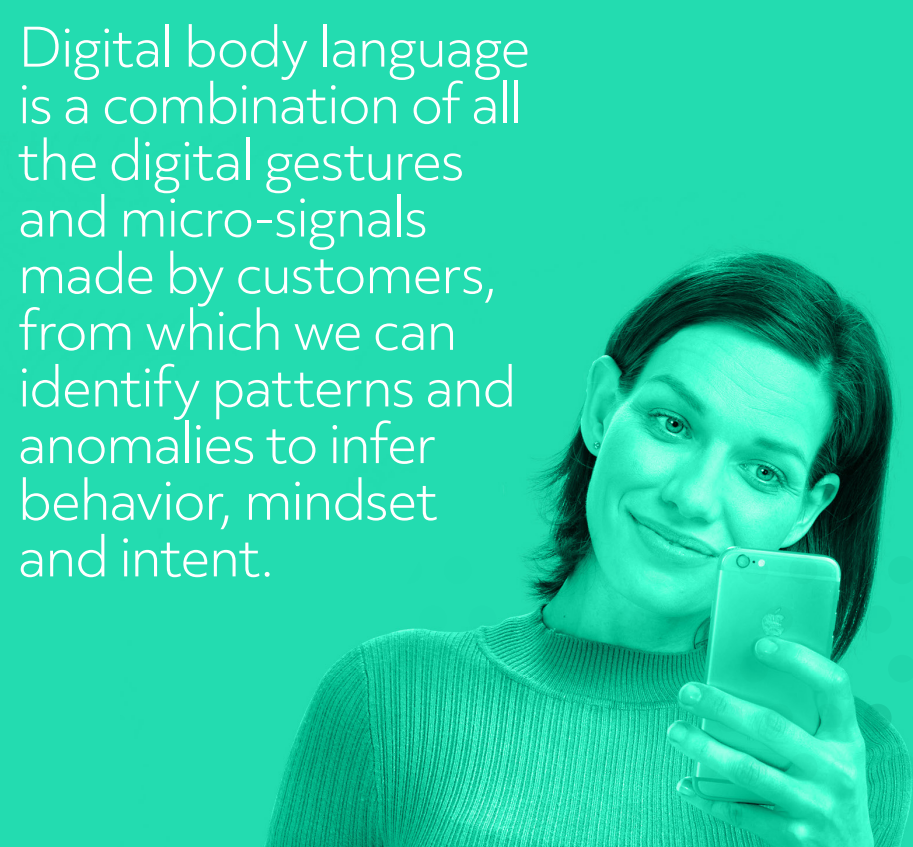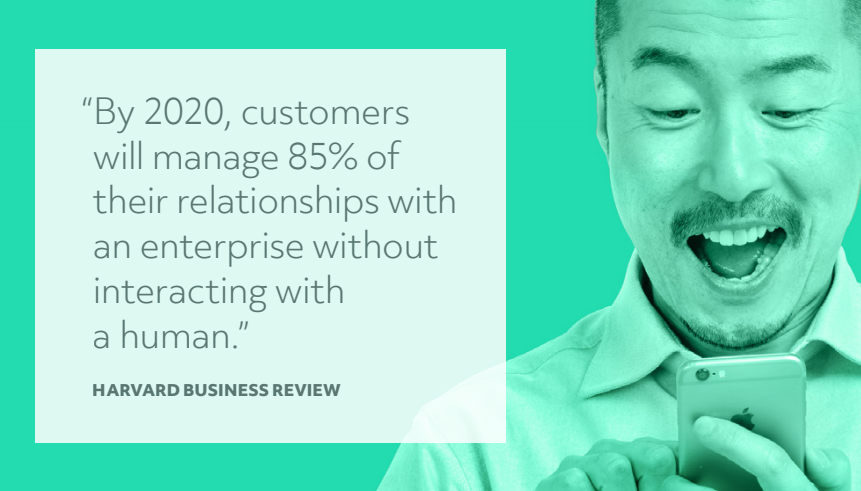
I’m interested in how people communicate and connect when they aren’t face to face or even communicating in real time, perhaps through an asynchronous forum or community such as Slack or Yammer.
Lori Niles-Hoffman, who is a Data Driven Learning Strategist, has experienced “the seismic shift from classroom to digital” in her career and this is what many professionals are dealing with – either embracing or struggling.
This is a pretty epic blog post exploring the topic in a fair amount of detail, with lots of links for you to read more.
What’s the short version?
The short version of this blog post is:
- Digital body language is all of the electronic stuff we do (or don’t do) online that you can analyse to understand people and what they want to do
- It comes from marketing, but we can, and should, apply it to L&D
- Face to face communication and training is changing, so we need to understand how to communicate with people differently
- Digital body language applies to groups, forums, enterprise social networks, social media, internal and external electronic behaviour, communities, webinars and virtual classrooms.
This is a February 2020 interview from Learning Now TV, about digital body language to give you a quick overview:
Here’s the long version…
What is DBL anyway?
According to Lori, it was Steve Woods who developed the term “Digital Body Language” in 2009.
Steve explains it this way on his blog:
Digital Body Language is the aggregate of all the digital activity you see from an individual. Each email that is opened or clicked, each web visit, each form, each search on Google, each referral from a social media property, and each webinar attended are part of the prospect’s digital body language.
In the same way that body language, as read by a sales person managing a deal, is an amalgamation of facial expressions, body posture, eye motions, and many other small details, digital body language is the amalgamation of all digital touchpoints.
This is a great introduction from the Clicktale e-book about customer’s body language:
Clicktale goes on in the document to say:
The same level [as face to face] of interaction and interpretation is achievable in the digital world. Every mouse move, hover, scroll, tap and pinch exposes structured behavioral patterns that determine customers’ digital body language and mindset.
Digital body language is a customer’s subconscious online behavior. Being able to interpret this digital body language is a must-have standard for the next wave of digital commerce.
Jamie Good, in his LinkedIn article, defined digital body language as:
The aggregate of an individual’s passive and active online activity
This focuses on the data generated when using computers and associated devices. It’s looking at what you click, or don’t click and a huge amount of other online measurements too. It can bring up issues of privacy and who owns the data, which Jamie’s article starts to discuss.
A lso this TLDCast discussion I hosted with HT2Labs CEO Ben Betts addresses some of the opportunities and challenges with data, xAPI, Learning Record Stores (LRS), the implications of GDPR and who owns what data.
lso this TLDCast discussion I hosted with HT2Labs CEO Ben Betts addresses some of the opportunities and challenges with data, xAPI, Learning Record Stores (LRS), the implications of GDPR and who owns what data.
This is all very well about data from platforms and websites, but we need to think about how this can apply in learning and development.
From face to face to digital comms
There’s a lot of change in corporate communications, sales, marketing and of course the way that not only do people learn, but also how we as L&D professionals communicate with our learners.
In her eBook, Lori Niles-Hoffman highlights that:
Sales and marketing departments experienced a similar challenge [to L&D departments] when customer relationships moved from face-to-face, nurtured relationships to online transactions.
…Connections are now developed via multiple and rapid online interactions.
Building on this point, Clicktale share some HBR insight:
We are increasingly seeing this change with learning offerings: not only through an LMS (learning management system); but also online communities/groups/forums as well as digital content offerings and virtual classrooms.
In her book Lori gives the example of what digital body language analysis can enable:
DBL analysis can show which content format is most appealing and at what time of day or week the customer prefers to engage.
From a marketing point of view Lori continues to explain that:
Once the DBL of a customer is decoded, then marketing can design content and campaigns that respond to these preferences.This increases the probability of positive and ongoing engagement with the brand and company.
And we can adapt this for learning and development when we are putting together learning campaigns and digital content for people at work. To this point, Lori shares that:
This type of thinking has not yet arrived in the learning industry. Every drop-off, click, or share is a learner shouting their likes and dislikes. These actions are the eye-rolls, smiles, and arms crossed from the classroom, simply in digital format. But we are not listening.
Read more about why Lori wrote her Data-Drive Learning Design eBook here.
Problems with digital body language for learning and development
Refocusing on the L&D professional, Lori highlights that that change with technology-enabled communications and learning transactions means that:
The in-person relationship is fading. Companies are shifting to digital modalities to avoid the associated travel and accommodation costs of face-to-face delivery.
This loss for learning professionals means the inability to real-time assess the engagement of learners.
Lori confirms what many face to face trainers, facilitators, teachers and presenters are afraid of:
The opportunity to read and adapt to the body language of participants in a classroom has vanished.
With regards specifically the virtual classroom, I wrote this article for Training Journal about facilitating A Group You Cannot See and what technology features are available for interacting with and engaging your attendees.
When thinking about the data to analyse, there are challenges in how to capture it. The Granify E-Commerce Blog, in an article by Lacie Larschan, highlight that:
The usefulness of digital body language depends heavily on the granularity of data captured…and even more challenging to interpret this data.
They highlight that there are ways to overcome the challenges:
This is why recent advances in machine learning have propelled the use of digital body language in marketing and sales campaigns.
A system powered by machine learning can detect patterns that might be hidden from even the best of human analysts.
This is another reason that, whilst you as an L&D professional might not specialise in this area, an awareness of computer and data trends are important as they will impact on how we work in the future.
Opportunities for digital body language
In their research paper Data-driven Learning: A Student-centered Technique for Language Learning, Touraj Talai and Zahra Fotovatnia reference Tim Johns about Data-Driven Learning:
Johns (1988) expressed that DDL entails a shift in the role of teachers and students. In other words the teacher works as a research director and collaborator instead of transmitting information to the students directly and explicitly.
If you want more depth, you can read a bit more from Tim himself in his paper Should You Be Persuaded – Two Samples of Data-Driven Learning Materials.
This is moving into an area of potentially using technology to provide curated materials to attendees, as well as analysing their online behaviour. We are moving into looking at not only the learning intervention and the ‘session’ as it is live, but also the broad and varies social interactions that surround this.
 Is this still digital body language when looking at social media and the various platforms that people use for work and learning (remembering of course that there’s huge overlap between those two).
Is this still digital body language when looking at social media and the various platforms that people use for work and learning (remembering of course that there’s huge overlap between those two).
Perhaps digital body language is a strict marketing term and in L&D we should focus on different terminology to describe further what we do. Is it “electronic body language” or “virtual body language”. Is it actually about “online communications” or “online behaviour analysis”.
Perhaps it doesn’t matter and the semantics aren’t the issue here – it’s more about understanding what we CAN include rather than exclude, and what we actually do.
What can digital body language help us do?
Community Roundtable co-founder Rachel Happe wrote on her blog about digital body language:
After years of watching people interact online it is clear to me that you can infer quite a bit about people’s unwritten intent.
Rachel goes on to give some examples, such as these based on Twitter:
- How and when someone inserts themselves into a public conversation
- What and who a person RTs [Re-Tweets] or shares
- How reactive and emotional individuals are (are they quick to judge or slower to respond to good/bad news?)
This is then focusing on the behaviour of an individual, and we need to include ourselves in this – as our professional profile, business owners, learners ourselves and of course in understanding the people we are interacting with in ways other than face to face.
On the Business 2 Community website, PureMatter CEO Bryan Kramer wrote an article about mastering your digital body language and stated that:
A company’s digital body language is an assessment of the collective behavior across the Internet, including marketing initiatives and user interactions in the earned, owned and paid sectors online.
As opportunities to interact socially are growing infinitesimally, paying attention to your personal digital body language – as a representative of both your personal brand and your company brand – is becoming critical.
….When you’re able to build a digital body language that reflects your authentic personal and corporate brand, true magic happens.
Bryan goes on to share ways to shape your own digital body language, which go towards the perception of your company or professional brand. His first point is “create and share heartfelt content” in order to “be authentic in everything that you represent” and avoid seeming manufactured.
Following this line of thought, Lisa Attygalle, Director of Engagement at Tamarack, wrote that:
There is a need for community engagement to become more focused on relationship-building rather than being transactional.
…Developing an understanding of digital body language may be helpful. I thought about some digital body language cues that may be visible in typical online engagement initiatives and suggested what they may infer.

Lisa goes on to give examples such as “on Facebook, responded as ‘Interested’ (not attending) to an in-person consultation event” the inference might be that they are “interested in contributing but the timing or location of the consultation may not suit.” Lisa also makes suggestions of your responses, such as inviting people to share their story on your blog if they have already commented in social media.
Lisa’s blog post is a really valuable list of behaviours, understandings and suggested responses to help with your thinking about your community, be it in a specific platform such as our own Lightbulb Moment free virtual classroom and webinar group, or your followers on social media.
So what?
With the different ways that we communicate in business, in our working lives and as learning professionals ourselves, we all need to know a little bit about digital body language. We need to understand the personal brand we have and as part of the organisation we work for.
In our organisations we need to start thinking about what data there is already that we can analyse, what can we perhaps start to collect and what we can do with that – especially with the learning management system being an ever-changing beast and there being so much rich data outside of it’s digital walls.
When thinking about our communities of practice the digital body language analysis we can make from an admin point of view of the data, as well as what community managers and contributors can understand and interpret as invested users or individual participants are going to be part of our daily lives, if they aren’t already.
And when we come to deliver learning solutions that include social learning through discussions groups/forums, maybe MOOCs and of course virtual classrooms and webinars, we need to be able to understand what the online behaviour is of people.
In the modern working and learning world, we can’t see everybody face to face. So it’s time to face up to digital body language.






This is a fascinating topic and one that thew Snapchat generation would find amusing. As digital natives, they naturally build relationships digitally. 3 things can we learn from them.
1. Frequency – relationships can’t be built via a monthly newsletter. What can you do on a daily basis ?
2. Be Brief – if you are sharing something – make it snappy. Consumable in under 60 seconds.
3. Be Visual – Video, photos, it’s all about the selfie
I’m always intrigued as a trainer by how a learner’s digital body language can be read during a live online learning session. What are the cues to pick up on that learners are engaged or need further clarity?
Regular use of the green tick function is certainly a good tip on platforms like Adobe Connect, but I’d be intrigued to see if anyone has done anything similar to Lisa Attygalle’s table (http://www.tamarackcommunity.ca/latest/digital-body-language) in the context of live online learning.
Great post Jo 🙂